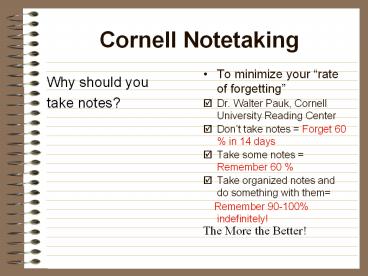Cornell%20Notetaking - PowerPoint PPT Presentation
Title:
Cornell%20Notetaking
Description:
Cornell Notetaking To minimize your rate of forgetting Dr. Walter Pauk, Cornell University Reading Center Don t take notes = Forget 60 % in 14 days – PowerPoint PPT presentation
Number of Views:347
Avg rating:3.0/5.0
Title: Cornell%20Notetaking
1
Cornell Notetaking
- To minimize your rate of forgetting
- Dr. Walter Pauk, Cornell University Reading
Center - Dont take notes Forget 60 in 14 days
- Take some notes Remember 60
- Take organized notes and do something with them
- Remember 90-100 indefinitely!
- Why should you
- take notes?
The More the Better!
2
Cornell Notetaking
- Dr. Pauk created the Cornell Notetaking System,
which is used at Stanford, UCLAs School of
Engineering, most Law Schools, and of course, at
Cornell University - The Cornell System requires the student to review
notes and think critically after learning has
taken place
Date Topic
Web, Picture Draw ??s
Summarize
3
Cornell Notetaking
- Notes are a record of your learning, so take them
when - You listen to a lecture
- You read a text
- You watch a film
- You work in a group on an activity
- You need to recall information about what
happened to you in a class, meeting, or
activity--which means always!
- When should you
- take notes?
4
Cornell Notetaking
- What do you notice that is different about
Cornell Notes?
- They are divided into two parts questions and
notes - There is a reflection at the end
- There is room for a topic
- They are labeled with name, date, class, period
or other information
5
Cornell Notetaking
- What types of
- questions should
- I place on the
- left side?
- Questions which are answered in the notes on the
right - Questions you still need the answer to--ask a
friend or the teacher after class - Questions the teacher might ask on a test
- Higher level thinking questions
6
Cornell Notetaking
- What else could
- I place on the
- left side?
- Key terms, vocabulary words, or dates
- Diagrams or figures
- Reference pages in a text
- Steps in a solution process
- Notes to myself about actions I need to take
7
Cornell Notetaking
- What are some
- good tips for
- taking the
- notes on the
- right?
- Write only what is most important
- listen for repetition, change in pace or volume,
numbering, explicit clues (this is important,
or on the test) - watch for gestures, or clues to organization
- look for material being written down by
instructor or shared in a visual manner
8
Cornell Notetaking
- What are some
- good tips for
- taking the
- notes on the
- right?
- Write in your own words (paraphrase)
- Write using abbreviations (check a dictionary for
these and create your own) - Draw a figure or diagram
- Leave space where you think you might need to
fill in info later - Use bullets, arrows, and indenting to list key
ideas - Write legibly
9
Cornell Notetaking
- What are some
- good tips for
- taking the
- notes on the
- right?
- Actively listen
- Use SLANT
- Maintain eye contact with the speaker, group, or
presentation source - Nod your head at appropriate times
- Frown when you do not understand
- Ask relevant questions
- Answer questions posed by the instructor
- Make a written record
10
Cornell Notetaking
- Set up your page
- Draw your margins
- Label clearly
- Take notes
- Use your best strategies
- Actively listen, analyze, ask questions
- Review, revise, reflect
- Look over notes and highlight, edit, or add info
- Write your questions and reflection
- What are the
- steps to taking
- Cornell Notes?





























